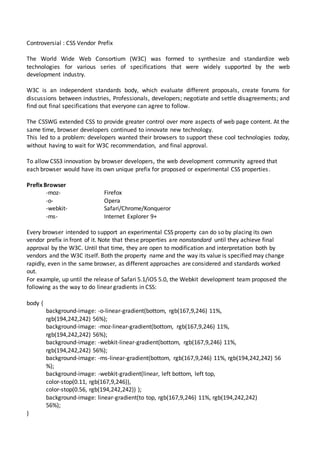
Controversial
- 1. Controversial : CSS Vendor Prefix The World Wide Web Consortium (W3C) was formed to synthesize and standardize web technologies for various series of specifications that were widely supported by the web development industry. W3C is an independent standards body, which evaluate different proposals, create forums for discussions between industries, Professionals, developers; negotiate and settle disagreements; and find out final specifications that everyone can agree to follow. The CSSWG extended CSS to provide greater control over more aspects of web page content. At the same time, browser developers continued to innovate new technology. This led to a problem: developers wanted their browsers to support these cool technologies today, without having to wait for W3C recommendation, and final approval. To allow CSS3 innovation by browser developers, the web development community agreed that each browser would have its own unique prefix for proposed or experimental CSS properties. Prefix Browser -moz- Firefox -o- Opera -webkit- Safari/Chrome/Konqueror -ms- Internet Explorer 9+ Every browser intended to support an experimental CSS property can do so by placing its own vendor prefix in front of it. Note that these properties are nonstandard until they achieve final approval by the W3C. Until that time, they are open to modification and interpretation both by vendors and the W3C itself. Both the property name and the way its value is specified may change rapidly, even in the same browser, as different approaches are considered and standards worked out. For example, up until the release of Safari 5.1/iOS 5.0, the Webkit development team proposed the following as the way to do linear gradients in CSS: body { background-image: -o-linear-gradient(bottom, rgb(167,9,246) 11%, rgb(194,242,242) 56%); background-image: -moz-linear-gradient(bottom, rgb(167,9,246) 11%, rgb(194,242,242) 56%); background-image: -webkit-linear-gradient(bottom, rgb(167,9,246) 11%, rgb(194,242,242) 56%); background-image: -ms-linear-gradient(bottom, rgb(167,9,246) 11%, rgb(194,242,242) 56 %); background-image: -webkit-gradient(linear, left bottom, left top, color-stop(0.11, rgb(167,9,246)), color-stop(0.56, rgb(194,242,242)) ); background-image: linear-gradient(to top, rgb(167,9,246) 11%, rgb(194,242,242) 56%); }
- 2. These two approaches produced the same result in each browser; under contention was which was the better way to code. In the case of gradients, the W3C took a third way, more closely related to the Firefox method: Table 1-1. Unique Browser Prefixes Safari/Chrome/Konqueror Internet Explorer 9+
